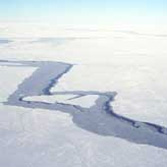Seasonal Development
By far the greatest seasonal changes in the ice thickness distribution of the East Antarctic pack are in the open water and thin ice categories. The amount of open water decreases from almost 60% in December to little more than 10% in August, and the thinnest ice thickness category (0 - 0.2 m) shows a 30% seasonal change between December and March. In contrast, the amount of ice greater than 1.0 m shows very little seasonal variability. This is because undeformed ice rarely exceeds 1 m thick, and the deformed ice greater than 1 m thick only comprises a small fraction of the pack, with the nature of the ice drift largely preventing the accumulation of the thicker ice to form multi-year ice. The fractional coverage of the different ice types discussed below are based upon data collected from 18 voyages into the East Antarctic pack between 1986 and 1995.
The Onset of Winter
In March, at the beginning of the growth season, there is approximately 25% open water and an additional 60% of ice less than 0.4 m. This is indicative of rapid new ice growth over large areas of the Southern Ocean as the air temperatures begin to cool, with very little differential drift between the new floes to form thicker ice by rafting.
As winter progresses the amount of open water within the pack decreases and new ice thickens quite rapidly due to the cold air temperatures. This leads to a decrease in the thinner ice categories and an associated increase in thicker ice. In August, the pack is quite consolidated, and the open water fraction averages 12%. There is only a small percentage of ice less than 0.4 m, and the ice between 0.4-0.8 m thick is of greatest concentration.

